Under the Hood—The Ethernet AVB Networking Backbone of VENUE | S6L
2015-12-24 11:59:54VENUE | S6L is a modular and scalable system that can be freely configured to meet the requirements of any live sound production. A key technology that enables this modularity is Ethernet AVB (also known as AVB/TSN)—the underlying network architecture used to connect the various system components. In this blog, we’re going to take a closer look at what Ethernet AVB is, explore why Avid chose it as S6L’s networking backbone, and take a look at some unique innovations that S6L offers to maximize the system’s performance.

What is Ethernet AVB?
Audio Video Bridging (AVB) is the common name for the set of technical standards developed by the Institute of Electrical and Electronics Engineers (IEEE)—the world’s largest association of technical professionals and one of the leading standards-making organizations. The institute’s notable networking standards include the IEEE 802.3 Ethernet standard and the IEEE 802.11 Wireless Networking standard.
The Audio Video Bridging Task Group of the IEEE 802.1 standards committee is responsible for providing the specifications that will allow time-synchronized low latency streaming services through IEEE 802 networks. The group has also developed a series of enhancements that provide highly reliable delivery of low latency, synchronized audio and video, without complex network engineering.

Furthermore, development of Ethernet AVB is not standing still. The IEEE recently added new enhancements called Time Sensitive Networking (TSN) that build upon the AVB specifications to expand the range, functionality, and applications of the AVB standard. This includes seamless redundancy and low-latency, high-priority control traffic for critical functions.
Finally, the AVnu Alliance, of which Avid is a member, has the job of guiding what is needed from the AVB/TSN specification for new applications across markets, and simplifying the process for engineers and designers to build products using Ethernet AVB. To help ensure interoperability between devices that implement the AVB standards, the AVnu Alliance develops device certification for the automotive, consumer, and professional audio and video markets and is actively involved in marketing Ethernet AVB’s benefits across these various markets.
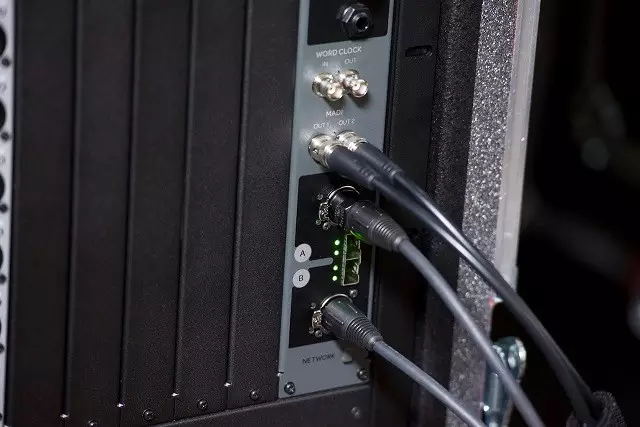
Stage 64 I/O Rack offers both etherCON (copper) and SFP (fiber) ports (supports both multi-mode and single-mode SFP transceivers)
Ethernet AVB offers several advantages for audio and video products:
Provides precise timing to support low-jitter media clocks and accurate synchronization of multiple A/V streams
Delivers assurance of timely packet deliveries through bounded latency
Offers extreme reliability, including a redundant clock master and redundant data traffic
Provides industry best practices for secure access and transactions
Requires little to no network configuration, meaning anyone can deploy a highly reliable networked A/V system
Has wide market appeal and adoption by industry leaders
Let’s take a closer look at a few of these benefits…
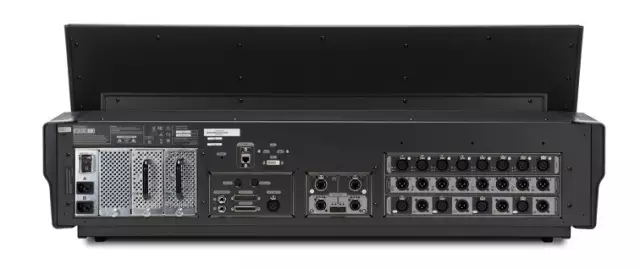
Back of the S6L-24D control surface - Ethernet AVB ports are located in the center area
Bounded latency and reserved bandwidth ensure reliable connections
With legacy Ethernet, the data traffic flow is indeterminate, and intervening traffic can delay stream data. Because of this uncertainty, the receivers in legacy systems typically employ large buffers so as not to underflow. One of the most important features of an Ethernet AVB network is that reserved streams pass through with a low and bounded latency, ensuring not only the arrival of time-sensitive streams, but also when they will arrive.
The IEEE created the Stream Reservation Protocol (SRP) as part of AVB because the simple stream treatment that existing reservation protocols provide was inadequate to the requirements of demanding applications, such as with professional A/V. In order to prevent network congestion that could result in packet loss and delivery delays, SRP configures a network path to provide the bandwidth needed, automatically setting up the associated hardware queues, packet forwarding, and VLAN configuration.
By controlling the queuing and data flow—in effect, smoothing out the delivery times to prevent the “bunching” of frames—an Ethernet AVB system is able to deliver the lowest possible latency without losing streams as you increase traffic. For this reason, AVB end stations (like live sound consoles) don’t need big buffers to solve congestion problems that could result in packet loss and delivery delays.
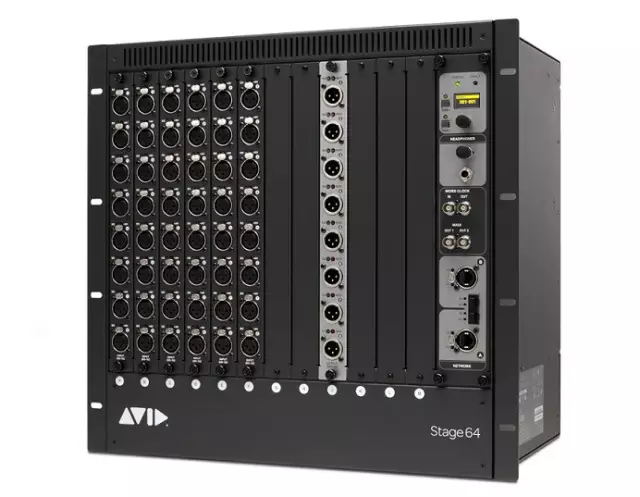
Multiple Stage 64 I/O Racks can be connected to the network and offer great flexibility with a range of input and output card options
Distributed timing keeps all of your devices in sync
A key benefit of Ethernet AVB is the synchronization of networked devices, which is enabled by gPTP (generalized Precision Time Protocol). The gPTP standard (IEEE 802.1AS) developed by the AVB Task Group provides a common time base needed for professional-quality audio and video clocking, as well as for time-sensitive streams such as industrial robotic controls (+/- 500ns of all gPTP nodes).
This level of synchronization is the underpinning that enables protocols built on gPTP (such as AVTP) to subsequently synchronize the media clocks of talkers and listeners with uncompromised professional quality. And because the timing information is distributed to all nodes (endpoint devices as well as switches), clocking in Ethernet AVB is very resilient, offering features for automatic changeover to a secondary master clock should the first one fail.

VENUE | S3L was Avid's first live system built on an Ethernet AVB architecture
Choosing Ethernet AVB for VENUE | S6L
During the initial stages of S6L development, our product group researched all of the available connectivity protocols—open and proprietary—to determine which solution would best fit the company’s needs for a comprehensive, overarching networking backbone across its various products moving forward. After assessing the strengths and weaknesses of each, the team determined that Ethernet AVB was the ideal solution because:
It supports the capacity required by our most demanding audio and video solutions
It provides the low latency required by professional A/V applications
It features fully deterministic playout
It’s built on open (non-proprietary) industry standards
And it’s free to implement, so it can be used across every product
In addition, Ethernet AVB enables our teams to develop products around a single company-wide, networked ecosystem—from high-end, professional solutions like S6L, all the way across our various audio and video product lines, and all the way down to our entry-level solutions. It’s also supported natively on every Mac sold, providing our customers with a free recording solution that doesn’t require any additional hardware or licenses.
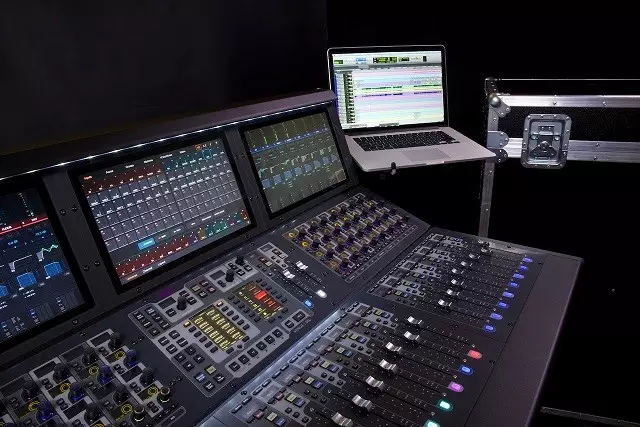
VENUE | S6L offers 64 tracks of Pro Tools recording and playback via Ethernet AVB
The fact that Ethernet AVB is based on non-proprietary industry standards also protects against any future uncertainty that may result from a single company’s financial hardship, manufacturing problem, or other issue. When you survey all of the various protocols that have come and gone in the audio industry, the ones that have stood up over time are open standards such as MIDI, MADI, and AES/EBU.
This is not to say that all proprietary protocols are doomed to failure, but the past is littered with protocols that have fallen by the wayside. Contrast this with Ethernet AVB, which is finding widespread adoption in industries beyond pro audio, including automotive and industrial applications. The fact that industry giants like Cisco, Intel, BMW, GE, General Motors, and others are adopting AVB and developing products around it demonstrates the protocol’s momentum and bodes well for its longevity well into the future.
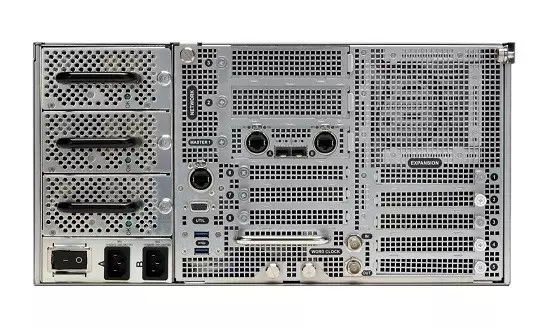
Back panel of the VENUE | E6L engine - expandable with additional AVB-192 Ethernet AVB Network Cards
Our secret sauce: the AVB-192 Ethernet AVB Network Card
Beyond the inherent benefits offered by Ethernet AVB, our engineers have further optimized the VENUE | S6L system’s performance by developing the AVB-192 Ethernet AVB Card, which is found in all three system components—the S6L control surface, E6L Engine, and Stage 64 I/O rack. In the case of the control surface and Stage 64, a single AVB-192 card is mounted internally, offering two independent Gigabit Ethernet ports—copper and fiber (via SFP).
The E6L Engine, on the other hand, ships standard with one AVB-192 card, but you will soon be able to expand it with up to three AVB-192 cards to support higher input and output counts. Each AVB-192 card offers hundreds of channels at 96 kHz operation—with the capability to support up to 192 kHz in the future.
Not only do these AVB-192 cards serve as the system’s Ethernet AVB connectivity points between the various system components, but each card also includes a built-in 7-port switch. In addition to making daisy-chaining easier, this enables you to run redundant loops between the various system components for even greater reliability, with seamless, sample-accurate switchover—with no dropout if a cable were to go down.

S6L will offer a range of connectivity options beyond Ethernet AVB
This onboard switch also enables the bridging of multiple AVB domains in the E6L engine to support the high channel counts offered by the system, as well as connectivity across multiple Stage 64 I/O racks, local control surface I/O, and external Pro Tools workstations for recording and playback (supporting runs up to 100 meters with Cat5e cables and longer runs up to 500 meters or more using fiber-optic cables).
Finally, although the recommended AVB latency is around 2 ms, the team has been able to tune the system’s network latency down to less than 1 ms in each direction. The total roundtrip, including converters, is less than 3 ms.
It’s important to note that, although Ethernet AVB is the backbone of the VENUE | S6L system, it does not in any way dictate your connectivity options to the larger world. Avid will offer a comprehensive array of other connectivity options beyond Ethernet AVB for S6L to ensure that you can connect the system into any existing environment. For example, we’ve already announced that Audinate is developing a Dante card for S6L, and there are other cards planned, including options for MADI and Thunderbolt.
Hopefully, you now have a better understanding of what Ethernet AVB is and why Avid has chosen this powerful and open standard as the networking backbone of the new S6L. As you can see, the significant capabilities that the AVB-192 Ethernet AVB Card brings to this groundbreaking live system will greatly benefit any live mixing application—especially with your most demanding productions.
*Source from Avid Blog December 1, 2015